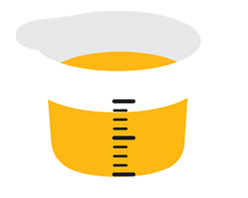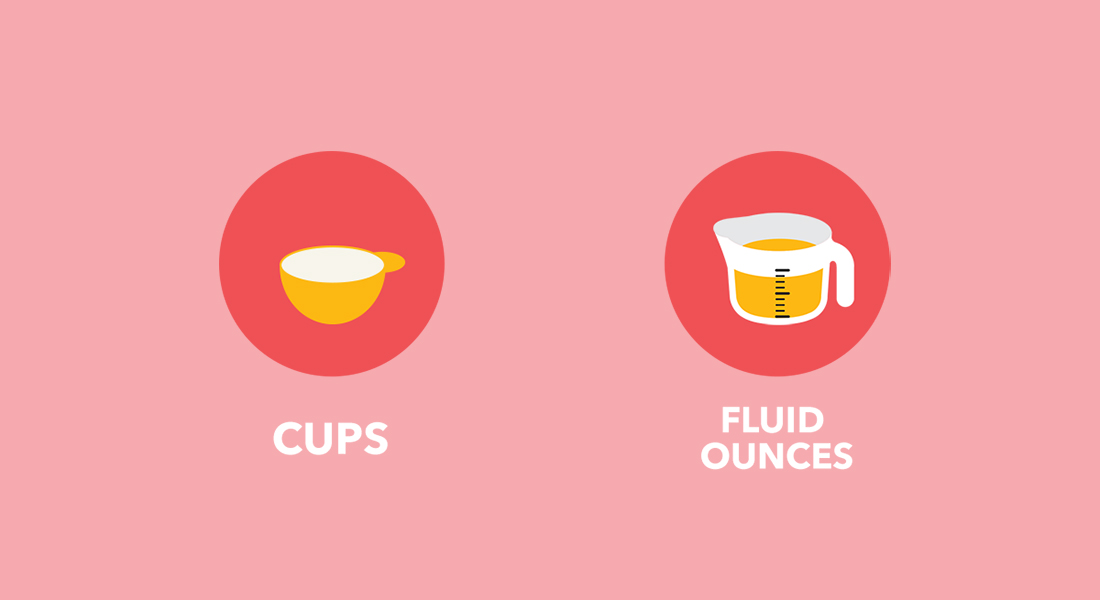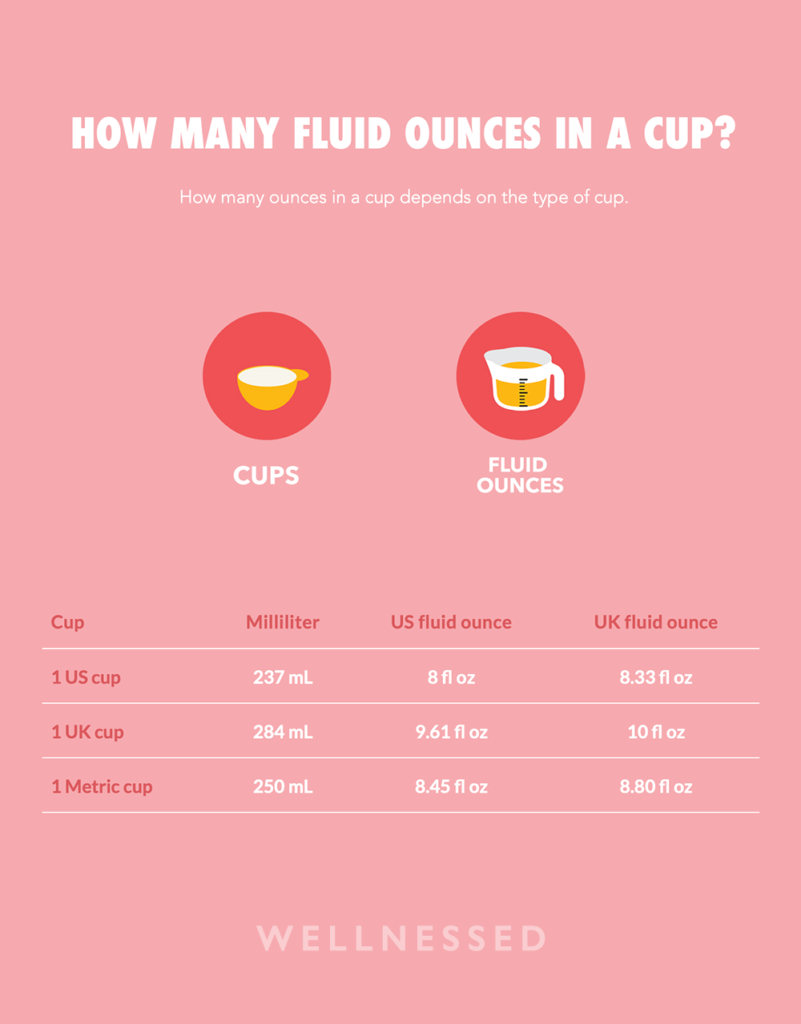Two of the most commonly used units of measurement for cooking are cups and ounces. Measuring out the right amount of ingredients is a key step to nailing a recipe, but it’s often easier said than done.
There are dry and liquid ingredients, different systems of measurement, and measurement units that measure different things but have the same name. Things can go sideways fast. So here’s a really easy guide on how to use ounces and cups, along with several measurement conversion charts.
Cups to Ounces Converter

Calculate how many ounces are in a cup (or vice versa) with this conversion calculator. Enter the amount, select which conversion you want, and then click convert.
What’s an Ounce?
The ounce is a unit that primarily used in the United States and United Kingdom system of measurement. It has its origins in Ancient Rome and today has become the root of a lot of confusion.1 Because there’s more than one type.
Types of Ounces
There are two main types of ounces used for measuring weight or volume:
- Dry ounce, which is also known as simply “ounce” or avoirdupois ounce, and is abbreviated oz. It measures weight, and is used to measure dry ingredients such as sugar and flour. Dry ounces are best measured with a scale.
- Fluid ounce, which is abbreviated fl oz. It measures volume, and is used to measure wet ingredients such as water or milk. Fluid ounces are measured with a measuring cup.
Dry ounces and fluid ounces are different units that measure different things
Often people refer to both dry and fluid ounces as simply ounces. However, dry ounces and fluid ounces are not interchangeable, they’re two entirely separate units of measurement that (unfortunately) happen to share a name.
What is a Cup?
The cup is a cooking measure of volume most commonly used in the United States that was popularized by Mary Lincoln and Fannie Farmer of the Boston Cooking School in the late nineteenth century. 2
Unlike ounces, a cup is a cup. It doesn’t matter if you’re using dry or liquid ingredients. A dry cup is the same as a wet cup. Although there are different types of measuring cups, you could use the same cup to measure everything. Because a cup is a cup is a cup.
Types of Measuring Cups
There are two types of measuring cups:
- Liquid measuring cups, which look like a pitcher with measurement markings on the side. They are commonly made of clear glass or plastic, and have a handle and a spout. You simply add your ingredient until it is even with the desired measurement line. Liquid measuring cups are best for liquids, because it makes pouring liquid easier and has extra space at the top to prevent spillage.
- Dry measuring cups are smaller, hold the exact amount, and often come in a set of different sizes. They are best used for dry ingredients, because you fill the cup until it spills over the top and level it off with the flat edge of a knife.
Both types of measuring cup ultimately measure the same amount
Any differences that exist in the world of cups have to do with accuracy and ease of use. Having said that, accuracy can be important, especially in baking. Measurements need to be exact when making things like cookies, candies, cakes, and bread. If the amounts are off, your cake may end up too dry or too wet instead of perfectly moist and tender. To ensure precision in baking it’s best to use the different types of measuring cups.
How Many Ounces in A Cup?
How many ounces there are in a cup depends on whether you’re measuring liquid or dry ingredients:
- Liquid ingredients. If you are using liquid ingredients, you’ll want to know how many fluid ounces are in a cup.
- Dry ingredients. If you are using dry ingredients, you’ll want to know how many dry ounces are in a cup.
Remember dry ounces and fluid ounces are not interchangeable. A lot of confusion arises because they’re both called ounces, and often people don’t differentiate between them. But they’re measuring two entirely different things. So let’s break it down.
How Many Fluid Ounces in a Cup?
There are 8 fluid ounces in one cup in the United States.
Whether you’re measuring water, milk, or cooking oil, there are 8 fluid ounces in one cup. In that sense it is very simple, except cup size is different in different parts of the world. Therefore the number of fluid ounces will vary depending on where you live. This is because they have a different measuring system.
There are three main systems of measurement you need to know about, especially if you’re using recipes from around the world:
- The States uses the US customary system, so the full name for a cup as a unit of measurement is actually a US customary cup.
- The UK uses the imperial system, so a cup is called an imperial cup.
- In countries that use the metric system, it’s called a metric cup.
Alas, cups are not the only unit of measurement that varies between countries. Fluid ounces in the UK imperial and US customary system are also different. The metric system does not have fluid ounces, but uses milliliters (mL). Thus in the chart below you’ll find the number of ounces (US and UK) and milliliters for each type of cup.
How Many Fluid Ounces in a Cup?
How many ounces in a cup depends on the type of cup.

| Cup | Milliliter | US fluid ounce | UK fluid ounce |
|---|---|---|---|
| 1 US cup | 237 mL | 8 fl oz | 8.33 fl oz |
| 1 UK cup | 284 mL | 9.61 fl oz | 10 fl oz |
| 1 Metric cup | 250 mL | 8.45 fl oz | 8.80 fl oz |
To make things a little easier we’ll just refer to US and UK units, instead of US customary units or imperial units.
The next chart converts US cups to US fluid ounces and milliliters for different amounts.
| US Cups | Milliliter | US Fluid Ounces |
|---|---|---|
| 1/4 cup | 59 mL | 2 fl oz |
| 1/3 cup | 79 mL | 2.7 fl oz |
| 1/2 cup | 118 mL | 4 fl oz |
| 2/3 cup | 158 mL | 5.3 fl oz |
| 3/4 cup | 177 mL | 6 fl oz |
| 1 cup | 237 mL | 8 fl oz |
| 2 cups | 473 mL | 16 fl oz |
| 4 cups | 946 mL | 32 fl oz |
| 8 cups | 1893 mL | 64 fl oz |
How Many Dry Ounces in a Cup?
For dry measurements, the answer depends on the specific food you are measuring. That’s because you’re now converting between volume (cups) and weight (dry ounces).
- Volume measures of the amount of space something takes up. Examples of volume measurements are cups, fluid ounces, pints, and gallons.
- Weight measures how heavy something is. Examples of weight measurements are grams, kilograms, dry ounces, and pounds.
You cannot simply interchange between volume and weight (with the exception of water). Why? Because the density for each food is different. For example, popcorn is less dense than brown sugar. One cup of popcorn weighs just 1/3 ounce, while one cup of brown sugar weighs a whopping 8 ounces.34 Same volume (1 cup), but different weight.
So what does that mean? Each type of ingredient and how it’s packed or cut will have a different weight. You’ll need a chart converting each food to ounces.
Cups to Ounces:
Conversion Chart for Common Ingredients
The chart below converts one US cup of food into ounces and grams.
You may have noticed from the conversion chart above that even the density of the same ingredient can vary. For example, the amount of flour in a cup can vary significantly depending on how you fill the cup, such as by spooning the flour into the cup versus dipping the cup into the flour. Just tapping the cup as you fill it will compact the flour, thereby increasing the density and how much will fit into the cup.
That’s why there are often further instructions when using cups to measure dry ingredients, such as level, rounded, heaping, firmly packed, lightly packed, unpacked (not packed), spooned, or sifted. And then there’s chopped, diced, sliced, and a whole lot more.
Cups to Ounces:
Conversion Chart for Fruit & Vegetables
The chart below converts one US cup of various fruit and vegetables into ounces and grams.5
When it comes to using cups as a measure, there’s also the order of words (and commas) to watch out for when following a recipe, lest you end up with a different amount of ingredient. For example, when a recipe stipulates “1 cup flour, sifted” it’s not the same as “1 cup sifted flour”. For the instruction of “1 cup flour, sifted” you measure the flour first and then sift, whereas for “1 cup sifted flour” you measure the sifted flour to the cup.
Those kind of instructions aren’t necessary when using a scale, because it already takes density into account. In other words, 1 cup of nuts can change depending on how tightly you pack the cup or cut the nuts, while 250 grams of nuts will always be 250 grams.


